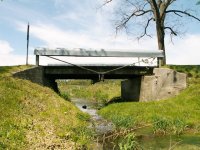Very nice sir!!!Thank you Doorman for posting. I'll have to look for your barn thread too. I never thought to look at this forum for projects. I'll be looking now. I'd like to see more pix of how the tubes are laid out.
I built a similar size bridge myself. It was one of my most fun projects ever. Hope it is for you too! A couple pix of the finished bridge. I wasn't intending to say so much, but only to encourage others to tackle what might at first seem hard. I built mine of treated wood: mostly 2x6x12's with a few 2x10 x12's. While I wouldn't hesitate to drive a car over it, if I could get it there, my goal was the Ford 8N I'm restoring. I had some free stuff. I salvaged about a 100 bolts which I used to bolt some 2x6's together. I did not bolt all of them, just those used to support the 8N width and my other smaller tractor width. It is sort of like a house floor under the 2x6 planks. I also had two I beams from my garage so those became my support ends on either side of the creek. I sunk 4x4 posts on the inside to hold in the beams which I just laid on a stone foundation. The main span was about 10-11 feet. But I extended both ends to take away the slope. I put one bolt in each of those, not two so that if it needed to rise for the water it would pivot. Only once that I know of did the water go that high. I watched the creek for a few years before this figuring out how high it would go. I used those 4x4 posts too to affix a roof truss to the center of the bridge for added support. I also looked at every bridge I came across while hiking various parks. After all this, I went on-line curious if there was any strength formulas. I guess that should have been my first step. But I was happy that what I did exceeded the expected weight. To relieve my erosion concern, (the bridge is in the middle of a horseshoe) I lined the creek edges with numerous 250 pound blocks that the local recycle shop had for free. But water is powerful. After several washed away, I then pounded rebar stakes through a few fortunate holes in the blocks and then bent over the ends.
If you poked thru some earlier posts I have pics of my other bridges.
2 are wood and one is a c-channel frame approx 12’ long.

